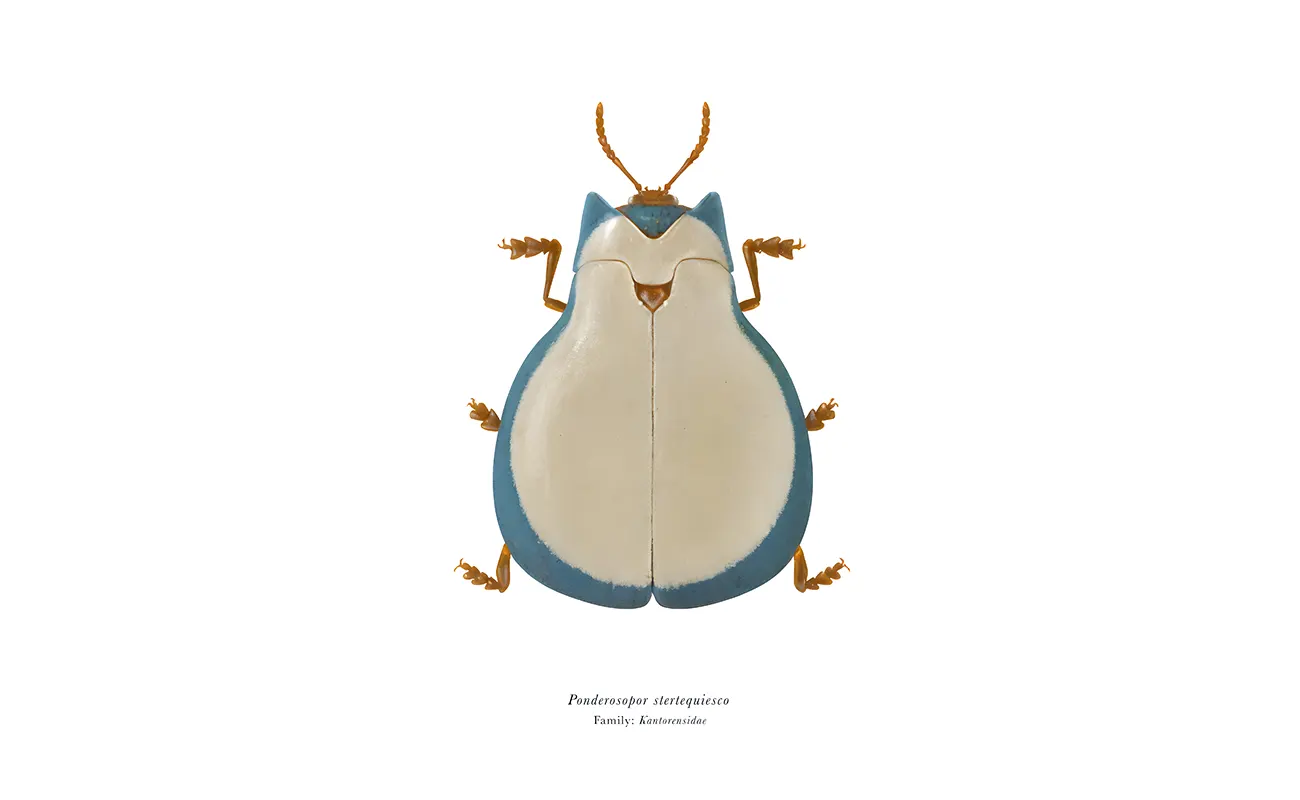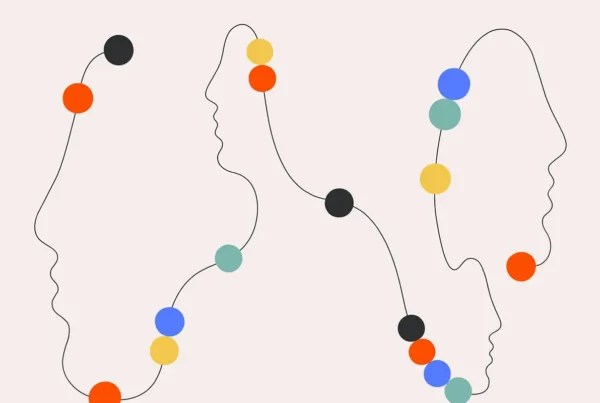“I loved the idea of combing the old natural history volumes with the fanatic collecting instinct of modern pop culture.”
Richard Wilkinson’s Art: Nurtured by Nature’s Wonders
Richard Wilkinson is an artist and illustrator hailing from the vibrant seaside city of Brighton, United Kingdom. Wilkinson’s formative years were spent in the lush expanses of Hampshire, where his father, a fervent amateur naturalist, regularly immersed him in the wonders of the natural world. Countless hours were dedicated to walking through the countryside, delving into the myriad variations of plants, fungi, and insects. Wilkinson’s domestic sphere was equally alive with intrigue, brimming with books rich in detailed depictions of diverse species, which offered him the joy of immersing himself in nature’s intricate and ceaseless array of forms.
Educational institutions also presented Wilkinson with a vast trove of resources. He frequently explored the school library, an oasis of knowledge, during the idle hours spent waiting for his father – an established headteacher – to finish work. His interests lay with comprehensive books, particularly those replete with detailed illustrations that served to categorise and explain a subject in its multifaceted variations.
Intrinsically curious, Wilkinson has always harboured a deep fascination for discovering the inherent patterns and interconnectedness within subjects. His artistic tendencies in childhood mirrored this penchant for detail, as exemplified by the richly populated battle scenes he created, brimming with individually distinct spacecraft, weaponry, and alien soldiers.
Wilkinson’s academic pursuit of art at the university level was somewhat marred by the perceived restrictiveness of the course, which was further exacerbated by a growing interest in electronic music. This newfound passion ushered him into a brief stint as a sound designer, producing audio for commercials and short films. Subsequently, this path evolved into a fleeting foray into the world of commercial production, which he found challenging to sustain.
During this transitional phase, Wilkinson found solace in his relationship with his future wife, a budding photographer. Her immersion in a world of pure creativity rekindled his desire to re-engage with visual arts. Consequently, Wilkinson began to produce art in his leisure time, ultimately amassing a portfolio that paved the way for his future ventures. He curated a website – a notable achievement in the era before social media – and reached out to various publications.
Fortune smiled upon Wilkinson when an Art Director team at The Telegraph supplement recognised his unique talent and awarded him a weekly commission. This opportunity allowed Wilkinson to hone his skills through conceptual illustrations for a column titled ‘Talking Point,’ thus challenging him to visualize a range of abstract and diverse ideas. This pivotal moment marked the beginning of Wilkinson’s journey to other illustration commissions and provided the impetus for exploring his individual artistic concepts.
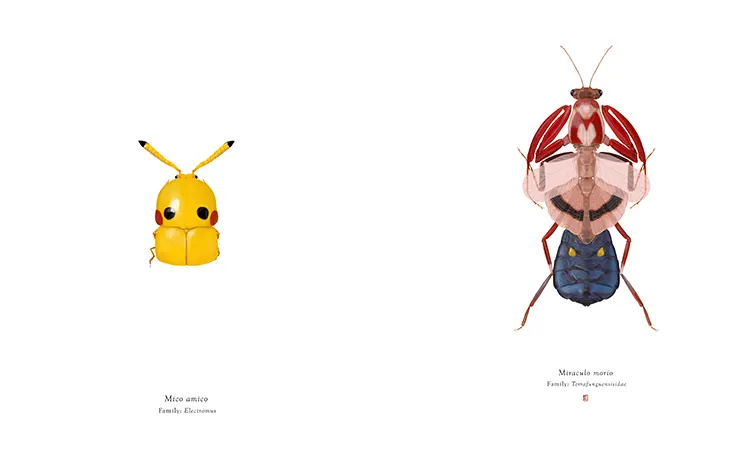
Capturing History and Science: Richard Wilkinson’s Victorian Inspirations
The artistic approach adopted by Richard Wilkinson is deeply rooted in the aesthetic traditions of Victorian scientific illustration. This rich artistic lineage, with its myriad natural history illustrators, fostered the duty-bound zeal to record and categorise every existing species, a feat that inspires Wilkinson’s work even today. His themes, encompassing natural history, entomology, botany, and the like, lend an archaic aura reminiscent of antique collections, imbuing his art with the profound textures of history and science.
Wilkinson’s oeuvre reflects a pervasive human instinct: the compulsive desire to compile, categorise, and comprehend the vast world around us. This unrelenting drive may stem from the primal yearning to grasp our surroundings, whether they pertain to the natural or the pop cultural realms. By exhaustively dissecting, enumerating, and cataloguing these discrete components, we seem to gain proximity and, consequently, deeper understanding of them. This behavioural pattern is evident in Wilkinson’s son, aged eleven, who enjoys assembling the components of various television shows or games. Such behaviour, Wilkinson admits, continues to fascinate him as well.
Such pervasive human proclivities kindled the genesis of Wilkinson’s ‘Arthropoda iconicus‘ project. The artist found himself enchanted by the idea of amalgamating the meticulous archival aesthetic of traditional natural history volumes with the obsessive accumulation characteristic of contemporary pop culture. He discerned an intriguing parallel between the vibrant allure of entomological details and the captivating aspects of cherished pop culture symbols. Moreover, the ubiquity of these icons, pervading the modern world just as insects populate a rainforest, struck a resonant chord. A Mickey Mouse toy, for example, becomes as abundant a species as Atlas Moths or Bullet Ants, reflecting millions of individual existences.
Furthermore, Wilkinson perceives a certain detachment achieved through this method of cataloguing. He likens it to trapping an ostentatious pop culture icon within a metaphorical killing jar, where it is subsequently pinned out in a minimalist white box frame for all to examine. This approach, in essence, encapsulates the quintessence of his artistry — the confluence of science, nature, and pop culture, preserved meticulously for posterity’s gaze.
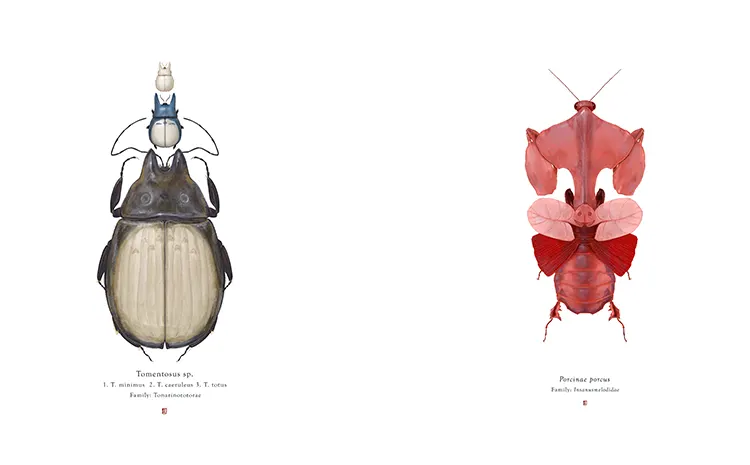
Influential Figures: Shaping Richard Wilkinson’s Artistic Path
The eminent figures who have left an indelible imprint on the artistic journey of Richard Wilkinson include Maria Sibylla Merian, Rachel Ruysch, Albrecht Dürer, Ernst Haeckel, Mary Delany, Eleazar Albin, Eugene Séguy, Jacques Fabian Gautier d’Agoty, Nicolas Henri Jacob, Walton Ford, John James Audubon, Walt Disney, Hayao Miyazaki, and Chuck Close.
His first encounter with Walton Ford’s piece, “American Flamingo”, became a revelation that stirred him profoundly. Familiar with the seminal works of Audubon to which Ford’s oeuvre alludes, Wilkinson recognized in Ford’s critique the imprints of imperialism inherent in the art form hitherto embraced by natural history artists. He was acutely aware of the Victorian era’s pervasive zeal to tame, domesticate, and civilize the untamed facets of nature—a culture mirroring the European ethos of the time.
Ford’s daring critique surfaced the underlying narrative of the hunter, the self-proclaimed custodian of the wild, inherent in Audubon’s depictions. Where Audubon portrayed a majestic flamingo, Ford unveiled a caricatured counterpart, snared in the act of being shot by distant hunters. This visual critique incited Wilkinson to dissect the concealed meanings embedded within these institutional styles, compelling him to revisit the nature catalogues he once deeply admired.
In his artistry, Wilkinson finds himself charting a trajectory that seems to diverge from Ford’s path. He employs the lexicon of natural history illustrations to reintroduce an essence of wilderness into the realm of pop culture, promoting a sense of tranquility and perhaps highlighting the parallels between the entities inhabiting nature and those saturating our contemporary lives.
The artist’s predilection for digital painting stems from the need to represent a large array of specimens in his work. The digital medium’s speed and flexibility provide an indispensable tool for Wilkinson, enabling him to develop ideas without an irreversible commitment to paper. As an individual striving for perfection, the transmutation of sketches into a final piece often presents an intimidating task. The liberty to modify and manipulate digital art eases this pressure, fostering an organic feel in his creative process. It further allows the retention of unforeseen elements and spontaneous ideas that occur during an artwork’s gestation.
Despite the constraints associated with traditional painting, Wilkinson harbors an appreciation for the tangible presence of a physical original, especially in an increasingly digital world. Consequently, he periodically entertains the idea of engaging more frequently with ‘real’ painting. However, a significant portion of his current portfolio centers on video and animation—an exciting avenue for the expression of his artistic visions.
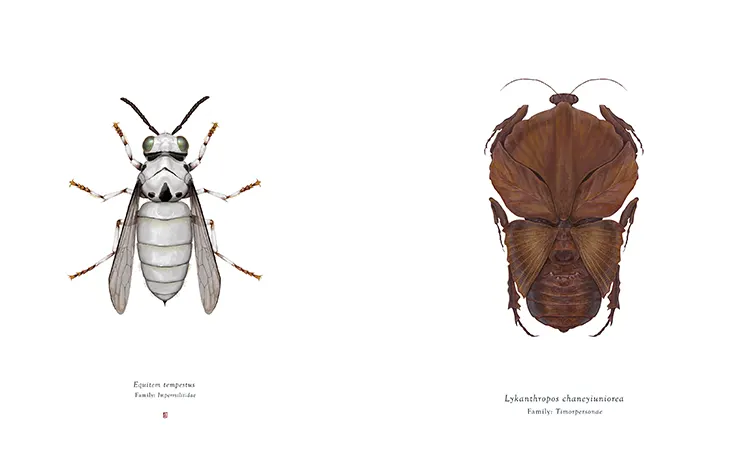
Artistic Creativity Unleashed: Richard Wilkinson’s Limited Resources, Unlimited Imagination
In the realm of artistic creativity, the equation between necessity and availability often diverges. This holds true for Richard Wilkinson, who operates with limited resources, yet accomplishes extraordinary feats. His primary tools consist of a modest desk, an iMac, and an iPad. However, his artistic rejuvenation relies heavily on frequent interactions with the natural world.
Wilkinson’s personal library is rich in catalogues detailing various species of insects and other arthropods. These serve as wellsprings of inspiration that he routinely draws upon. Nevertheless, managing distractions can prove challenging for the artist, as his attention tends to stray and delve into fascinating yet unexpected tangents. Whether it’s an intricate investigation into the world of mantises or the meticulous detail of a Ghibli character’s attire, Wilkinson’s curiosity is a complex and unpredictable entity. The breadth of his imaginative scope can lead him to a labyrinth of diverse ideas, or it can pull him into a whirlwind of tasks that demand immediate attention. In this constant battle with distractions, the artist admits, he has yet to discover a truly effective strategy.
Recently, Wilkinson’s creative pursuits have been directed towards an intriguing collection of botanical illustrations that ingeniously incorporate elements from contemporary pop culture. The size and prominence of these pieces present him with an exciting dilemma: should they be traditional paintings, or should they venture into the dynamic realm of 3D? A similar question arises when he contemplates bringing his insect inspirations to life as three-dimensional specimens. This endeavor would require collaboration with a skilled model-maker or a proficient 3D artist, a prospect that brings a new layer of challenge and excitement to Wilkinson’s artistic journey.



